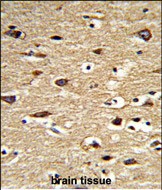POLG2 Antibody (Center)
Purified Rabbit Polyclonal Antibody (Pab)
- SPECIFICATION
- CITATIONS
- PROTOCOLS
- BACKGROUND

Application
| IHC-P, WB, E |
|---|---|
| Primary Accession | Q9UHN1 |
| Reactivity | Human |
| Host | Rabbit |
| Clonality | Polyclonal |
| Isotype | Rabbit IgG |
| Calculated MW | 54911 Da |
| Antigen Region | 205-234 aa |
| Gene ID | 11232 |
|---|---|
| Other Names | DNA polymerase subunit gamma-2, mitochondrial, DNA polymerase gamma accessory 55 kDa subunit, p55, Mitochondrial DNA polymerase accessory subunit, MtPolB, PolG-beta, POLG2, MTPOLB |
| Target/Specificity | This POLG2 antibody is generated from rabbits immunized with a KLH conjugated synthetic peptide between 205-234 amino acids from the Central region of human POLG2. |
| Dilution | IHC-P~~1:50~100 WB~~1:1000 E~~Use at an assay dependent concentration. |
| Format | Purified polyclonal antibody supplied in PBS with 0.09% (W/V) sodium azide. This antibody is prepared by Saturated Ammonium Sulfate (SAS) precipitation followed by dialysis against PBS. |
| Storage | Maintain refrigerated at 2-8°C for up to 2 weeks. For long term storage store at -20°C in small aliquots to prevent freeze-thaw cycles. |
| Precautions | POLG2 Antibody (Center) is for research use only and not for use in diagnostic or therapeutic procedures. |
| Name | POLG2 {ECO:0000303|PubMed:30157269, ECO:0000312|HGNC:HGNC:9180} |
|---|---|
| Function | Accessory subunit of DNA polymerase gamma solely responsible for replication of mitochondrial DNA (mtDNA). Acts as an allosteric regulator of the holoenzyme activities. Enhances the polymerase activity and the processivity of POLG by increasing its interactions with the DNA template. Suppresses POLG exonucleolytic proofreading especially toward homopolymeric templates bearing mismatched termini. Binds to single-stranded DNA. |
| Cellular Location | Mitochondrion {ECO:0000250|UniProtKB:P54098}. Mitochondrion matrix, mitochondrion nucleoid {ECO:0000250|UniProtKB:P54098} |

Thousands of laboratories across the world have published research that depended on the performance of antibodies from Abcepta to advance their research. Check out links to articles that cite our products in major peer-reviewed journals, organized by research category.
info@abcepta.com, and receive a free "I Love Antibodies" mug.
Provided below are standard protocols that you may find useful for product applications.
Background
The accuracy of mitochondrial DNA (mtDNA) replication depends on the coordinated action of many nuclear-encoded proteins and on the correct balance of nucleotides within the mitochondrial matrix. mtDNA is replicated by DNA polymerase gamma, which is composed of a 140-kD catalytic subunit(POLG1) and a 55-kD accessory subunit (POLG2).
References
Longley,M.J., Am. J. Hum. Genet. 78 (6), 1026-1034 (2006)
Carrodeguas,J.A., J. Biol. Chem. 277 (51), 50008-50014 (2002)
If you have used an Abcepta product and would like to share how it has performed, please click on the "Submit Review" button and provide the requested information. Our staff will examine and post your review and contact you if needed.
If you have any additional inquiries please email technical services at tech@abcepta.com.













 Foundational characteristics of cancer include proliferation, angiogenesis, migration, evasion of apoptosis, and cellular immortality. Find key markers for these cellular processes and antibodies to detect them.
Foundational characteristics of cancer include proliferation, angiogenesis, migration, evasion of apoptosis, and cellular immortality. Find key markers for these cellular processes and antibodies to detect them. The SUMOplot™ Analysis Program predicts and scores sumoylation sites in your protein. SUMOylation is a post-translational modification involved in various cellular processes, such as nuclear-cytosolic transport, transcriptional regulation, apoptosis, protein stability, response to stress, and progression through the cell cycle.
The SUMOplot™ Analysis Program predicts and scores sumoylation sites in your protein. SUMOylation is a post-translational modification involved in various cellular processes, such as nuclear-cytosolic transport, transcriptional regulation, apoptosis, protein stability, response to stress, and progression through the cell cycle. The Autophagy Receptor Motif Plotter predicts and scores autophagy receptor binding sites in your protein. Identifying proteins connected to this pathway is critical to understanding the role of autophagy in physiological as well as pathological processes such as development, differentiation, neurodegenerative diseases, stress, infection, and cancer.
The Autophagy Receptor Motif Plotter predicts and scores autophagy receptor binding sites in your protein. Identifying proteins connected to this pathway is critical to understanding the role of autophagy in physiological as well as pathological processes such as development, differentiation, neurodegenerative diseases, stress, infection, and cancer.




